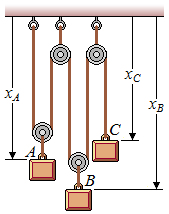Details
Sometimes, the position of a particle will depend upon the position of another particle or of several other particles. The motions are then said to be dependent. For example, the position of block B in the figure shown below depends upon the position of block A:

Since rope ACDEFG is of constant length, and since the lengths of the portions of rope CD and EF wrapped around the pulleys remain constant, it follows that the sum of the lengths of the segments AC, DE, and FG is constant. Observing that the length of the segment AC differs from xA only by a constant and that, similarly, the lengths of the segments DE and FG differ from xB only by a constant:
xA + 2xB = constant
Since only one of the two coordinates xA and xB can be chosen arbitrarily, it is said that the system shown above has one degreeof freedom. From the relation between the position coordinates xA and xB, it follows that if xA is given an increment ΔxA, that is, if block A is lowered by an amount ΔxA, the coordinate xB will receive an increment ΔxB = −½ΔxA. In other words, block B will rise by half the same amount; this can be checked directly from the above figure.
In the case of the three blocks as shown in the following figure:

It is observed that the length of the rope which passes over the pulleys is constant, and thus the following relation must be satisfied by the position coordinates of the three blocks:
2xA + 2xB + xC = constant
Since two of the coordinates can be chosen arbitrarily, it can be said that the three block system above has two degrees of freedom.
When the relation existing between the position coordinates of several particles is linear, a similar relation holds between the velocities and between the accelerations of the particles. In the case of the blocks of the previous figure, for instance, the equation is differentiated to obtain for velocity:
or:
2vA + 2vB + vC = 0
and differentiating again for acceleration:
or:
2aA + 2aB + aC = 0

